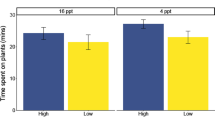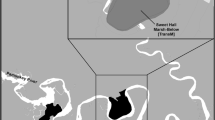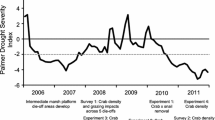Abstract
The objective of this study was to experimentally evaluate the effects of simulated herbivory on the ability of a freshwater marsh plant to recover from temporary saltwater intrusion such as can be caused by tropical storms. Sods containingSagittaria lancifolia, a dominant plant in interior coastal marshes, were manipulated in the field so as to subject plants to a pulse of 15‰ salt water for a duration of 1 wk. In addition to the exposure to salt water, some plants were also subjected to both short-term and long-term flooding treatments of 20 cm, and to simulated herbivory (clipping). Following exposure to salt water, plants were allowed to recover over the winter and were harvested the next June. Neither simulated herbivory, nor salinity, nor flooding caused any long-term effect either singly or in pairwise combinations. However, when plants were subjected to herbivory, salt water, and flooding simultaneously, reduced growth and plant death occurred. These results suggest that high levels of grazing by herbivores may increase the susceptibility of coastal marsh plants to damage from saltwater intrusion. *** DIRECT SUPPORT *** A01BY073 00002
Similar content being viewed by others
Literature Cited
Bakker, J. P. 1985. The impact of grazing on plant communities, plant populations, and soil conditions on salt marshes.Vegetatio 63:391–398.
Bazely, D. R. andR. L. Jefferies. 1986. Changes in the composition and standing crop of saltmarsh communities in response to the removal of a grazer.Journal of Ecology 74:693–706.
Boorman, L. A. andR. M. Fuller. 1981. The changing status of reedswamp in the Norfolk Broads.Journal of Applied Ecology 18:241–269.
Brewer, J. S. andJ. B. Grace. 1990. Vegetation structure of an oligohaline tidal marsh.Vegetatio 90:93–107.
Chabreck, R. H. 1972. Vegetation, water and soil characteristics of the Louisiana coastal region. Louisiana Agricultural Experiment Station Bulletin 664. Baton Rouge, Louisiana.
Chabreck, R. H. 1988. Coastal Marshes. University of Minnesota Press, Minneapolis, Minnesota.
Craig, N. J., R. E. Turner andJ. W. Day, Jr. 1980. Wetland losses and their consequences in coastal Louisiana.Zeitschrift fur Geomorphologie Neue Folge (Suppl.) 31:225–241.
Day, J. W., W. H. Conner, R. Costanza, G. P. Kemp, andI. A. Mendelssohn. 1993. Impacts of sea level rise on coastal systems with special emphasis on the Mississippi River deltaic plain, p. 270–296.In R. A. Warrick, E. M. Barrow, and T. M. L. Wigley (eds.), Climate and Sea Level Change: Observations, Projections and Implications. Cambridge University Press, Oxford.
Flynn, K. M. 1992. Effects of hydrologic alterations on the vegetation and soils of marshes in southern Louisiana. Ph.D. Dissertation, Louisiana State University, Baton Rouge, Louisiana.
Fuller, D. A., C. E. Sasser, W. B. Johnsson, andJ. G. Gosselink. 1985. The effects of herbivory on vegetation on islands in Atchafalaya Bay, Louisiana.Wetlands 4:105–114.
Gosselink, J. G. 1984. The Ecology of Delta Marshes of Coastal Louisiana: A Community Profile. United States Fish and Wildlife Service FWS/OBS84/09. 134 p.
Gough, L., J. B. Grace, andK. L. Taylors. 1994. The relationship between species richness and community biomass: The importance of environmental variables.Oikos 70:271–279.
Guntenspergen, G. R., D. Cahoon, J. B. Grace, G. Steyer, S. Fournet, M. A. Townson, andA. L. Foote. 1995. Disturbance and recovery of the Louisiana coastal marsh landscape from the impacts of Hurricane Andrew.Journal of Coastal Research 18:324–339.
Herndon, A., L. Gunderson, andJ. Stenberg. 1991. Sawgrass (Cladium jamaicense) survival in a regime of fire and flooding.Wetlands 11:17–28.
Howard, R. J. andI. A. Mendelssohn. 1995. Effect of increased water depth on growth of a common perennial freshwater-intermediate marsh species in coastal Louisiana.Wetlands Wetlands 15:82–91.
Kinler, N. W., R. G. Linscombe, andP. R. Ramsey. 1987. Nutria, p. 326–344.In M. Novak, J. A. Baker, M. E. Obbard, and B. Mallock (eds.), Furbearer Management and Conservation in North America. Ministry of Natural Resources, Toronto, Ontario, Canada.
Linscombe, G. 1992. Current status of nutria populations and potential solutions, p. 272.In M. Landin (ed.), Wetlands: Proceedings of the 13th Annual Conference, South Central Chapter, Society of Wetland Scientists. Utica, Mississippi.
Linscombe, G., N. Kinler, and V. Wright. 1981. Nutria population density and vegetative changes in brackish marsh in coastal Louisiana, p. 129–141.In J. A. Chapman and D. Pursley (eds.), Worldwide Furbearers Conference Proceedings Vol. 1. Frostburg, Maryland.
Llewellyn, D. W. andG. P. Shaffer. 1993. Marsh restoration in the presence of intense herbivory: The role ofJusticia lanceolata (Chapm.) Small.Wetlands 13:176–184.
Lowery, G. H., Jr. 1981. The Mammals of Louisiana and its adjacent waters. Louisiana State University Press, Baton Rouge, Louisiana.
McKee, K. L. andI. A. Mendelssohn. 1989. Response of a freshwater marsh plant community to increased salinity and increased water level.Aquatic Botany 34:301–316.
Mitsch, W. J. andJ. G. Gosselink. 1986. Wetlands. Van Nostrand Reinhold Company, New York.
Moore, P. D. andS. B. Chapman. 1986. Methods in Plant Ecology. Blackwell Scientific Publishers, London.
Nyman, J. A., R. H. Chabreck, andN. W. Kinler. 1993. Some effects of herbivory and 30 year of weir management on emergent vegetation in brackish marsh.Wetlands 13:165–175
Odum, W. E., T. J. Smith, III, J. K. Hoover, and C. C. McIvor. 1984. The Ecology of Tidal Freshwater Marshes of the United State East Coast: A Community Profile. United States Fish and Wildlife Service FWS/OBS-83/17.
O'Neil, T. 1949. The muskrat in the Louisiana coastal marsh. Louisiana Department of Wildlife and Fisheries, New Orleans, Louisiana.
Pezeshki, S. R., R. D. DeLaune, andW. H. Patrick, Jr. 1987. Effects of flooding and salinity on photosynthesis ofSagittaria lancifolia.Marine Ecology Progress Series. 41:87–91.
Sale, P. J. M. andR. G. Wetzel. 1983. Growth and metabolism ofTypha species in relation to cutting treatments.Aquatic Botany 15:321–334.
Salinas, L. M., R. D. DeLaune, andW. H. Patrick, Jr. 1986. Changes occurring along a rapidly submerging coastal area: Louisiana, USA.Journal of Coastal Research 2:269–284.
Smith, L. M. andJ. A. Kadlec. 1985. Fire and herbivory in a Great Salt Lake marsh.Ecology 66:259–265.
Sokal, R. R. andF. J. Rohlf. 1981. Biometry. Freeman Publishers, New York.
Stumm, W. andJ. J. Morgan. 1970. Aquatic Chemistry. John Wiley and Sons Publishers, New York.
Taylor, K. L. 1992. Effects of Vertebrate Herbivory on Louisiana Coastal Marshes. Ph.D. Dissertation, Louisiana State University, Baton Rouge, Louisiana.
Taylor, K. L., J. B. Grace, G. R. Guntenspergen, andA. L. Foote. 1994. The interactive effects of herbivory and fire on an oligohaline marsh, Little Lake, Louisiana, USA.Wetlands 14:82–87.
Templet, P. H. andK. J. Meyer-Arendt. 1988. Louisiana wetland loss: A regional water management approach to the problem.Environmental Management 12:181–192.
Turner, R. E. andD. R. Cahoon (eds.). 1988. Causes of Wetland Loss in the Coastal Central Gulf of Mexico. Volume II. Minerals Management Service, New Orleans, Louisiana. OCS Study/MMS 87-0120.
Vallentine, J. M. 1977. Plant succession after saw-grass mortality in southwestern Louisiana.Proceedings of a Congress of the Southeastern Association of Game and Fish Commissions 30:634–640.
Weller, M. W. 1981. Freshwater Marshes. University of Minnesota Press, Minneapolis, Minnesota.
Wilsey, B. J., R. H. Chabreck, andR. G. Lincombe. 1991. Variation in nutria diets in selected freshwater wetlands of Louisiana.Wetlands 11:263–278.
Wiseman, W. J., Jr., andE. M. Swenson. 1988. Long-term salinity trends in Louisiana estuaries.In R. E. Turner and D. R. Cahoon (eds.), 1988. Causes of Wetlands Loss in the Coastal Central Gulf of Mexico. Vols. I–III. Minerals Management Service, New Orleans, Louisianas. OCS Study/MMS 87-0120.
Wiseman, W. J., Jr.E. M. Swenson, andJ. Power. 1990. Salinity trends in Louisiana estuaries.Estuaries 13:265–271.
Author information
Authors and Affiliations
Rights and permissions
About this article
Cite this article
Grace, J.B., Ford, M.A. The potential impact of herbivores on the susceptibility of the marsh plantSagittaria lancifolia to saltwater intrusion in coastal wetlands. Estuaries 19, 13–20 (1996). https://doi.org/10.2307/1352647
Received:
Accepted:
Issue Date:
DOI: https://doi.org/10.2307/1352647




